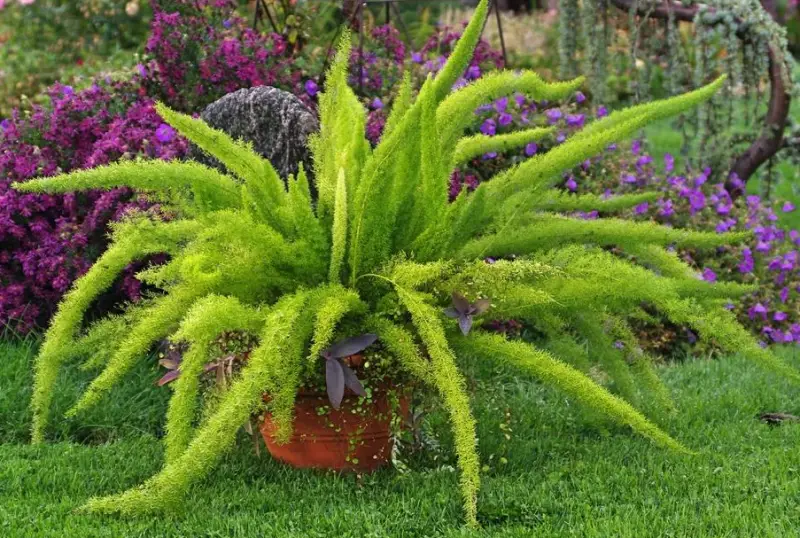The Foxtail Fern (Asparagus densiflorus) is a captivating, low-maintenance plant known for its fluffy, plume-like foliage. Despite its name, it’s not actually a fern! As a member of the asparagus family, this hardy perennial is unique because it reproduces through seeds rather than spores, as true ferns do. With its vibrant green fronds and small, bright red berries, the foxtail fern makes an excellent addition to both indoor spaces and outdoor landscapes.
In this guide, we’ll dive into the essentials for growing and caring for foxtail ferns and explore how to maintain their lush, bushy appearance year-round.
Basic Facts about Foxtail Fern

- Common Names: Foxtail fern, asparagus fern, plume asparagus, emerald feather, plumosa fern.
- Scientific Name: Asparagus densiflorus
- Family: Asparagaceae
- Plant Type: Perennial evergreen
- Size: Grows up to 2-3 feet in height and width
- Sun Exposure: Prefers partial sunlight
- Soil Type: Well-draining
- Soil pH: Acidic to neutral
- Bloom Time: Spring
- Flower Color: White flowers with vibrant red berries
- Hardiness Zones: USDA Zones 9a-11a
- Toxicity: All parts, including berries, are toxic to humans and pets
Choosing the Right Spot for Foxtail Fern
Light Requirements
Foxtail ferns thrive in bright, indirect light but can tolerate a bit of direct morning sun. However, too much intense sunlight—especially in the afternoon—may scorch their delicate foliage. Indoors, place your fern near a window where it can receive filtered light. Outdoors, a shaded area with dappled sunlight is ideal.
Temperature and Humidity
Native to Africa, foxtail ferns do well in warm and humid environments. They prefer temperatures between 65°F and 75°F. Humidity is a key factor; adding a pebble tray with water nearby or misting occasionally can keep your fern happy indoors. If you live in a climate where temperatures dip below 50°F, consider moving potted ferns inside during winter.
Soil and Watering Needs
Soil Requirements
This adaptable plant does well in a variety of soil types as long as it’s well-draining. Slightly acidic soil is preferred, but it’s not a strict requirement. For potted plants, use a potting mix with good drainage properties or amend garden soil with perlite or sand to improve aeration.
Watering Schedule
Foxtail ferns have tuberous roots that store water, making them drought-tolerant. Overwatering can lead to root rot, so it’s best to let the soil dry out slightly between waterings. Aim to water about once a week, allowing the top few inches of soil to dry out. During particularly hot, dry spells, you may need to increase watering, but always check the soil first.
Fertilizing Foxtail Ferns
To keep your foxtail fern lush and green, it’s best to fertilize regularly during the growing season (spring and summer). Use a balanced fertilizer with an equal ratio, such as a 10-10-10 formula, and apply at half the recommended strength once a month. Slow-release or liquid fertilizers work well; simply avoid over-fertilizing, as this can lead to burned roots and damaged foliage.
Pruning and Maintenance
Pruning
Trimming your foxtail fern encourages new growth and helps maintain its bushy shape. Remove any yellow or dry fronds at the base using sharp garden shears. This improves air circulation, reducing the risk of fungal infections.
Dividing Foxtail Ferns
The easiest way to propagate a foxtail fern is by division, usually done in early spring. Using a sharp spade or knife, divide the root ball in half, ensuring each section has both roots and foliage. Plant each division in fresh soil, water thoroughly, and keep it in indirect sunlight.
Growing Foxtail Ferns from Seed
Growing foxtail ferns from seeds is a rewarding method, though it requires more time. You can collect seeds from the red berries that appear after the foxtail fern blooms.
Here’s a simple step-by-step guide for growing foxtail ferns from seed:
- Collect ripe red berries from an established foxtail fern.
- Soak the berries in water overnight, then remove the pulp to expose the seeds.
- Plant the seeds in small containers filled with a moist potting mix, ideally mixed with vermiculite for better aeration.
- Cover the containers with plastic wrap to maintain humidity.
- Place them in indirect sunlight, and mist the soil regularly. Seeds typically germinate within three to four weeks.
Potting and Repotting Foxtail Fern
When potting foxtail ferns, choose clay or porous stone pots, which allow excess moisture to evaporate. This helps prevent overwatering issues and mimics the fern’s natural environment. As the plant grows, you may notice roots peeking out from the soil. This signals the need for repotting. Choose a pot only slightly larger than the previous one, as excessive space can lead to moisture retention.
Common Pests and Diseases
Foxtail ferns are relatively resistant to pests but can sometimes be affected by mealybugs and scale insects. These sap-sucking pests can be managed with organic neem oil. Regular inspection and cleaning of foliage help prevent infestations.
Fungal Issues
If you notice yellowing leaves or stunted growth, the plant may be suffering from crown rot, often due to overwatering. Ensure proper drainage, especially for potted plants, and consider adding a fungicide if fungal issues persist.
Seasonal Care and Overwintering
In regions with cold winters, it’s essential to protect foxtail ferns from frost. Outdoor plants go dormant during winter, so stop fertilizing and reduce watering frequency, keeping the soil just slightly moist. Spread a layer of mulch around the base of outdoor ferns to insulate the roots.
For potted ferns, relocate them indoors before the first frost and place them near a sunny window. Keep the plant’s surroundings humid to prevent drying out, but be prepared for some leaf drop as the plant adapts to indoor conditions.
Common Issues and Solutions
Yellowing Leaves
If your foxtail fern’s leaves turn yellow, this may be due to overwatering or insufficient light. Adjust your watering schedule and move the plant to a brighter location.
Stunted Growth
Poor growth may be due to nutrient deficiency or root-bound conditions. Ensure your plant receives adequate fertilizer during the growing season, and consider repotting if it outgrows its pot.
Burned Leaves
If your fern’s leaves develop brown tips or burn marks, it might be receiving too much direct sunlight. Relocate it to a spot with filtered or indirect light to prevent further damage.
Using Foxtail Fern in Garden and Decor
Outdoor Gardens
The foxtail fern is a versatile addition to any garden, providing texture and vibrant color. Its dense foliage serves as an excellent ground cover and pairs well with other plants of contrasting colors and textures.
Indoor Decor
In indoor spaces, the foxtail fern’s lush greenery adds a refreshing touch. Place it in a decorative pot to complement your interior style, from modern to rustic. Its long-lasting fronds are also used in floral arrangements, lasting two to three weeks when cut.
Final Thoughts
The foxtail fern is a striking, hardy plant that requires minimal maintenance yet adds a lush, feathery charm to any space. With the right care, this plant will thrive indoors or outdoors, giving you year-round greenery. Remember to provide well-draining soil, avoid overwatering, and protect it from harsh sunlight and winter frost. Whether you’re looking to expand your indoor plant collection or add texture to your garden, the foxtail fern is a beautiful, enduring choice.






